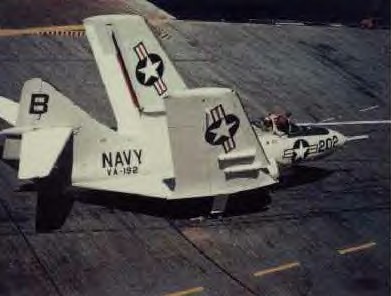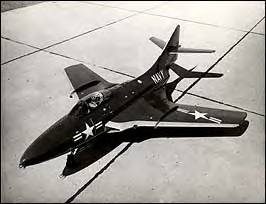The XF9F-2/XF9F-3 Panther contract awarded in October of 1946 had included a clause calling for design data on a swept-wing version. However, Grumman was worried about the poor low-speed characteristics of swept-wing aircraft, and prevailed upon the Navy to postpone work on a swept-winged version of the Panther.
However, the development of a swept-wing Panther was made more urgent by the appearance of the MiG-15 in Korea in November of 1950. The MiG-15 was powered by derivatives of the same Rolls-Royce Nene as was the Panther, but was nearly 100 mph faster. The very next month, the Navy and Grumman both agreed that it was urgent to press forward with the development of a swept-wing version of the Panther. A contract for the modification of three F9F-5 airframes was signed on March 2, 1951. The project was assigned the company designation Design 93.
Grumman's Design 93 was a more-or-less straightforward swept-wing conversion of the Panther. It retained the fuselage, vertical tail, engine, and undercarriage of the F9F-5, but was fitted with wings swept at 35 degrees and with swept horizontal tail surfaces. In order to reduce the approach and stalling speeds to acceptable levels, the chord of the leading-edge slats and the trailing-edge flaps were both increased. Much larger split flaps were fitted underneath the fuselage center section. The fuselage was increased in length by 2 feet, and the the wingroot-mounted intakes were extended farther forward and the wing root fillets were enlarged. A broader chord lower rudder section was fitted, linked to the rudder pedals. The upper rudder section was unchanged, but was linked to a yaw damper. The wingtip tanks had to be eliminated, and the resulting reduction in fuel capacity was partially offset by increasing the size of the forward-fuselage fuel tank and by adding bladder-type fuel tanks in the wing leading edge. Nevertheless, the internal fuel capacity was only 919 US gallons, as compared with 1003 US gallons for the F9F-5.
Since the Design 93 was so different from the F9F-5, one might have expected that the Navy would assign a new manufacturer type sequence number to it. Since the next available number for Grumman was 11, the new design by all rights should have been designated F11F-1. However, for some reason, the Navy decided to assign it the next configuration sequence number in the original Panther manufacturer type sequence, and the swept-wing version of the Panther was designated F9F-6. However, a new name was given to the swept-wing F9F-6--Cougar, thus continuing the tradition of assigning feline names to Grumman-built fighter aircraft.
Two flying prototypes (126670 and 126672) and a static test airframe (126671) were obtained by converting three uncompleted F9F-5 airframes to F9F-6 configuration. Work on the swept-wing Cougar proceeded quite rapidly and the first F9F-6 (BuNo 126670) was ready for its first flight only six months after the signing of the contract. It took to the air for the first time on September 20, 1951, with test pilot Fred C. Rowley at the controls. The plane was powered by a Pratt & Whitney J48-P-6 turbojet rated at 6250 lb.st. takeoff dry and 7000 lb.s.t. takeoff with water injection. It had conventional horn-balanced ailerons for lateral control and conventional tab geared elevators for longitudinal control. Early test flights revealed that the F9F-6 had a tendency towards control reversal at high speeds, and had rather poor lateral and longitudinal control. The adoption of an all-flying horizontal tailplane cured the reversibility problem. The lateral control problem was cured by the addition of "flaperon/flaperette" spoilers fitted to the upper wing surfaces. In normal flight, both of these spoiler sections operated as a single unit, but the flaperette section could operate independently. Large wing fences were found necessary to inhibit spanwise airflow and to preserve lateral control effectiveness.
 To everyone's surprise and amazement, the prototype F9F-6 actually had better carrier handling characteristics than the straight-winged F9F-5. The critical Mach number was increased from 0.79 to 0.86 at sea level and to 0.895 at 35,000 feet. The prototype (126670) was later re-engined with a YJ48-P-8 turbojet rated at 7250 lb.s.t. without the need for water injection.
To everyone's surprise and amazement, the prototype F9F-6 actually had better carrier handling characteristics than the straight-winged F9F-5. The critical Mach number was increased from 0.79 to 0.86 at sea level and to 0.895 at 35,000 feet. The prototype (126670) was later re-engined with a YJ48-P-8 turbojet rated at 7250 lb.s.t. without the need for water injection.
The first 30 production F9F-6s were powered by the 7000 lb.s.t. J48-P-6A, but the remainder of the F9F-6 order was powered by the 7250 lb.s.t. J48-P-8 turbojet. The built-in armament consisted of four 20-mm cannon. In addition, the aircraft had two wing racks for 1000-pound bombs or 150-US gallon drop tanks.
The first unit to receive the F9F-6 was VF-32, which converted to the Cougar in November of 1952. However, the Cougar was too late to fly combat sorties in Korea. The last of 646 F9F-6 Cougars was delivered on July 2, 1954.
In 1953, the Blue Angels flight demonstration team transitioned from F9F-5 Panthers to F9F-6 Cougars. However, the team's Cougars were urgently needed by operational squadrons, and the Blue Angels were forced to re-equip briefly with F9F-5s. In 1954, the Blue Angels traded in their F9F-5s for F9F-8 Cougars.
In service, F9F-6s were often fitted with a UHF homing antenna in a fairing underneath the nose. A few even had an inflight refuelling probe installed in the nose.
Three probe-equipped F9F-6s flown by VF-21 made the first US transcontinental crossing in less than four hours on April 1, 1954, the fastest time being 3 hours 45 minutes 30 seconds for a distance of 2438 miles.
Sixty F9F-6 Cougar airframes were fitted by Grumman with a camera installation in the nose in place of the cannon, and were were delivered under the designation F9F-6P between June 1954 and March 1955. The nose was slightly longer (the length increasing from 41 feet 5 inches to 42 feet 1 7/8 inches). All armament was deleted.
Following the withdrawal of F9F-6s from active service, several F9F-6s were modified as F9F-6D drone directors or as F9F-6K drones. The F9F-6K2 designation identified F9F-6Ks which were equipped with modernized equipment, as a well as a number of F9F-6s which were fitted directly with this newer equipment. The designation F9F-6PD was assigned to two F9F-6Ps (BuNos 127475 and 128308) that were modified as target controller planes.
In 1962, the Defense Department introduced the new Tri-Service designation scheme under which the separate USAF/Navy designations were replaced by a new unified designation system. This required that all existing Navy aircraft be redesignated. The F9F-6 was redesignated F-9F, with the F9F-6D, F9F-6K, and F9F-6K2 being redesignated DF-9F, QF-9F, and QF-9G respectively. The F9F-6P reconnaissance aircraft was redesignated RF-9F.
 Manufacturer: Grumman
Manufacturer: Grumman
Basic role: Fighter
Powerplant: Pratt & Whitney J48-P-8A
Thrust (each): 7,250 lbs (3,287 kg)
Crew: Pilot
Length: 42' 2"
Height: 12' 3"
Wingspan: 34' 6"
Wingarea: 337.0 sq ft
Empty Weight: 11,866 lbs
Gross Weight: 20,098 lbs
Max Weight: 24,763 lbs
Range: 1,208 miles
Cruise Speed: 516 mph (830 kph)
Max Speed: 647 mph (1,041 kph)
Climb: 5,750 ft/min
Ceiling: 42,000 ft
